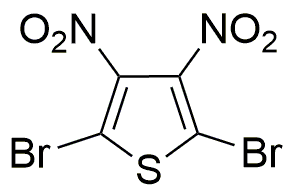2,5-Dibromo-3,4-dinitrothiophene is widely utilized in research focused on:
- Organic Electronics: This compound is used in the development of organic semiconductors, which are essential for creating flexible electronic devices such as organic light-emitting diodes (OLEDs) and organic solar cells.
- Pesticide Formulation: It serves as an intermediate in the synthesis of agrochemicals, particularly in developing effective pesticides that target specific pests while minimizing environmental impact.
- Material Science: The compound is explored for its properties in creating advanced materials, including polymers that exhibit enhanced thermal and electrical conductivity.
- Analytical Chemistry: It is utilized as a reagent in various analytical methods, aiding researchers in detecting and quantifying other chemical substances in complex mixtures.
- Pharmaceutical Development: The compound is investigated for potential applications in drug formulation, particularly in creating compounds that can target specific biological pathways.
Informations générales
Propriétés
Sécurité et réglementation
Applications
2,5-Dibromo-3,4-dinitrothiophene is widely utilized in research focused on:
- Organic Electronics: This compound is used in the development of organic semiconductors, which are essential for creating flexible electronic devices such as organic light-emitting diodes (OLEDs) and organic solar cells.
- Pesticide Formulation: It serves as an intermediate in the synthesis of agrochemicals, particularly in developing effective pesticides that target specific pests while minimizing environmental impact.
- Material Science: The compound is explored for its properties in creating advanced materials, including polymers that exhibit enhanced thermal and electrical conductivity.
- Analytical Chemistry: It is utilized as a reagent in various analytical methods, aiding researchers in detecting and quantifying other chemical substances in complex mixtures.
- Pharmaceutical Development: The compound is investigated for potential applications in drug formulation, particularly in creating compounds that can target specific biological pathways.
Documents
Fiches de données de sécurité (FDS)
La FDS fournit des informations de sécurité complètes sur la manipulation, le stockage et l’élimination du produit.
Spécifications du produit (PS)
Le PS fournit une description complète des propriétés du produit, notamment sa composition chimique, son état physique, sa pureté et les exigences de stockage. Il détaille également les plages de qualité acceptables et les applications prévues du produit.
Certificats d'analyse (COA)
Recherchez des certificats d'analyse (COA) en saisissant le numéro de lot du produit. Les numéros de lot et de lot se trouvent sur l'étiquette d'un produit, après les mots « Lot » ou « Lot de fabrication ».
Numéro de catalogue
Numéro de lot/série
Certificats d'origine (COO)
Ce certificat d'exploitation confirme le pays dans lequel le produit a été fabriqué, et détaille également les matériaux et composants utilisés et s'il est issu de sources naturelles, synthétiques ou autres sources spécifiques. Ce certificat peut être requis pour les douanes, le commerce et la conformité réglementaire.
Numéro de catalogue
Numéro de lot/série
Fiches de données de sécurité (FDS)
La FDS fournit des informations de sécurité complètes sur la manipulation, le stockage et l’élimination du produit.
DownloadSpécifications du produit (PS)
Le PS fournit une description complète des propriétés du produit, notamment sa composition chimique, son état physique, sa pureté et les exigences de stockage. Il détaille également les plages de qualité acceptables et les applications prévues du produit.
DownloadCertificats d'analyse (COA)
Recherchez des certificats d'analyse (COA) en saisissant le numéro de lot du produit. Les numéros de lot et de lot se trouvent sur l'étiquette d'un produit, après les mots « Lot » ou « Lot de fabrication ».
Numéro de catalogue
Numéro de lot/série
Certificats d'origine (COO)
Ce certificat d'exploitation confirme le pays dans lequel le produit a été fabriqué, et détaille également les matériaux et composants utilisés et s'il est issu de sources naturelles, synthétiques ou autres sources spécifiques. Ce certificat peut être requis pour les douanes, le commerce et la conformité réglementaire.


